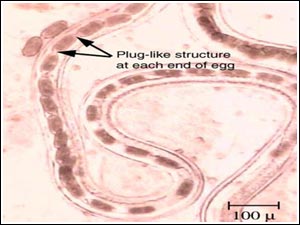

 |
||||||||||||
 |
||||||||||||
| Nematode (Roundworm) Infections in Fish | ||||||
| Page 7 of 11 | Pages: 1 . 2 . 3 . 4 . 5 . 6 . 7 . 8 . 9 . 10 . 11 | |||||
Representative Nematode (Roundworm) Species Capillaria Species The Capillarids as a group can infect a wide variety of fish hosts. Capillaria pterophylli is a relatively common nematode seen in the intestines of cichlids (including angelfish and discus). Capillaria species are also seen in cyprinids, gouramis, tetras and other species of fish. Capillaria females are easily identified when they are carrying the brown, barrel-shaped eggs with a plug-like structure on each end ( Figure 10 ).  Figure 10: Capillaria female showing eggs with plug-like structures at each end.
Figure 10: Capillaria female showing eggs with plug-like structures at each end.
Capillaria species have direct life cycles, and can spread from one fish to another by ingestion of infective eggs. It may take Capillaria pterophylli eggs up to three weeks at 68-73°F (less time at warmer temperatures) before they contain embryos developed enough to be infective when ingested by a fish. The length of time required from infection until the mature adult parasites are producing eggs or larvae is approximately three months at these temperatures. Even though Capillaria species have direct life cycles, a tubifex worm may act as a paratenic (alternative) host and "carry" infective stages of Capillaria to the fish that consumes them. Diagnosis Capillaria species are relatively transparent and, if immature or male nematodes only are present, may be easily missed during necropsy. However, Capillarid infection is relatively easy to diagnose when females containing the typical barrel-shaped eggs with a polar plug on each end (opercula) are present in the intestinal tract or the eggs alone are present. Treatment Capillarid infections can be treated with dewormers such as levamisole or fenbendazole (see General Treatment Notes). To avoid reinfection, organic debris and feces should be removed as often as possible, especially following deworming treatment. Prevention Brood stock should be evaluated for the presence of nematodes prior to use and periodically throughout the breeding period. Proper sanitation will help prevent the spread of nematodes and reduce infection loads. Live foods, such as oligochaete worms (e.g., tubifex worms), may act as carriers, and their use should be avoided if possible. more ... |
 |
|||||
| About Us :: Message Board :: Chat | |||||
| Library :: Photo Gallery :: Links & Resources :: Breeders & Sponsors :: Merchandise | |||||
| Website designed by: EthanCote.com | © 2001-2004, SimplyDiscus.com. All Rights Reserved. | ||||